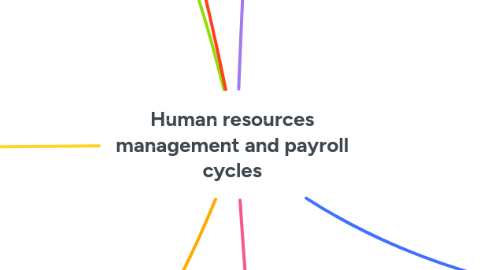
1. Updating the payroll master database
1.1. Process
1.1.1. Update information about tax rates and other payroll deductions
1.2. Threats and controls
1.2.1. Unauthorized changes to payroll master data
1.2.1.1. Segregation of duties
1.2.1.2. Access controls
1.2.2. Inaccurate updating of payroll master data
1.2.2.1. Data processing integrity controls
1.2.2.2. Regular review of all changes to master payroll data
2. Validate time and attendance data
2.1. Process
2.1.1. Time card
2.1.2. Time sheet
2.1.3. Carefully record the amount of their sales
2.1.4. bonus/incentive schemes
2.2. Threats and controls
2.2.1. Inaccurate time and attendance data
2.2.1.1. Source data automation for data capture
2.2.1.2. Biometric authentication
2.2.1.3. Segregation of duties
2.2.1.4. Supervisory review
3. Disburse payroll taxes and miscellaneous deductions
3.1. Process
3.1.1. Pay Social Security taxes
3.1.2. Flexible benefits plans
3.2. Threats and controls
3.2.1. Failure to make required payments
3.2.1.1. Configuration of system to make required payments using current instructions from IRS
3.2.2. Untimely payments
3.2.2.1. Configuration of system to make required payments using current instructions from IRS
3.2.3. Inaccurate payments
3.2.3.1. Processing integrity controls
3.2.3.2. Supervisory review of reports
3.2.3.3. Employee review of earnings statement
4. Dispurse payroll
4.1. Process
4.1.1. Disbursement voucher
4.1.2. Cashier prepares and signs a check transferring funds to the company’s payroll bank account
4.1.3. Cashier promptly redeposits any unclaimed paychecks in the company’s bank account
4.1.4. Direct deposit
4.1.5. Payroll debit cards
4.2. Threats and Controls
4.2.1. Theft or fraudulent distribution of paychecks
4.2.1.1. Restriction of physical access to blank payroll checks and the check signature machine
4.2.1.2. Restriction of access to the EFT system
4.2.1.3. Prenumbering and periodically accounting for all payroll checks and review of all EFT direct deposit transactions
4.2.1.4. Require proper supporting documentation for all paychecks
4.2.1.5. Use of a separate checking account for payroll, maintained as an imprest fund
4.2.1.6. Segregation of duties
4.2.1.7. Restriction of access to payroll master database
4.2.1.8. Verification of identity of all employees receiving paychecks
4.2.1.9. Redepositing unclaimed paychecks and investigating cause
5. Knowledge management systems
6. Threats and controls
6.1. Inaccurate or invalid master data
6.1.1. Data processing integrity controls
6.1.2. Restriction of access to master data
6.1.3. Review of all changes to master data
6.2. Unauthorized disclosure of sensitive information
6.2.1. Access controls
6.2.2. Encryption
6.2.3. Tokenization
6.3. Loss or destruction of data
6.3.1. Backup and disaster recovery procedures
6.4. Hiring unqualified or larcenous employees
6.4.1. Sound hiring procedures, including verification of job applicants’ credentials, skills, references, and employment history
6.4.2. Criminal background investigation checks of all applicants for finance- related positions
6.5. Violations of employment laws
6.5.1. Thorough documentation of hiring, performance evaluation, and dismissal procedures
6.5.2. Continuing education on changes in employment laws
7. Prepare Payroll
7.1. Process
7.1.1. Payroll transaction data is edited and sorted
7.1.2. Prepare employee paychecks
7.1.3. All payroll deductions are summed, and the total is subtracted from gross pay to obtain net pay
7.1.4. Payroll register
7.1.5. Deduction register
7.1.6. Earning statement
7.2. Threats and controls
7.2.1. Errors in processing payroll
7.2.1.1. Supervisory review of payroll register and other reports
7.2.1.2. Issuing earnings statements to employees
7.2.1.3. Review of IRS guidelines to ensure proper classification of workers as either employees or independent contractors
